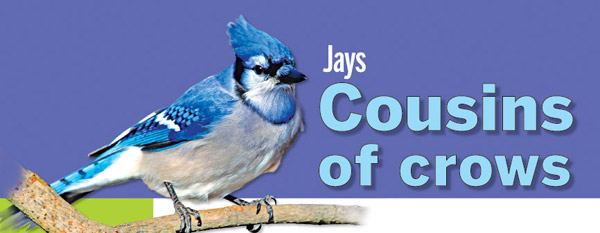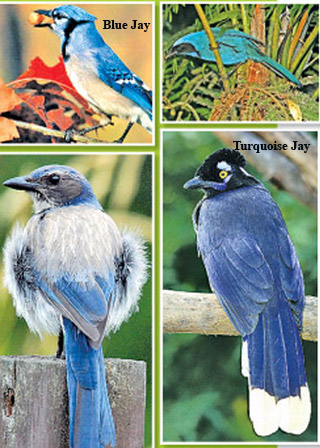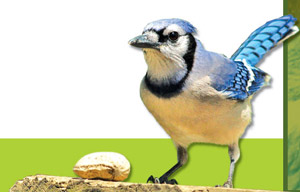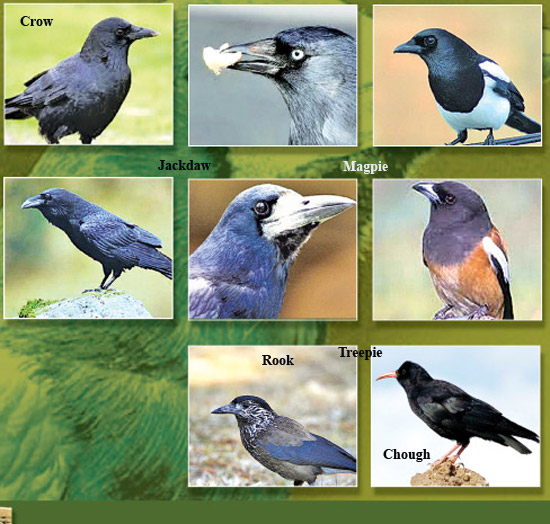|

Fast Facts
* Jays have complex social systems with tight family bonds.
* Jays are one of the most important natural planters of acron and
are responsible for the distribution of several species of oak. A single
jay could 'plant' up to 3,000 acorns in a single month.
* Blue (American) Jays include the Azme Jay, Blue Jay, Brown Jay,
Dwarf Jay, Green Jay, Mexican Jay, Turquoise Jay, Yucatan Jay, Plush
crested Jay, Steller's Jay, Unicoloured Jay, Curl-crested Jay and Black-chested
Jay among others.
* Some Brown (Old World) Jays are-Lidth's Jay, Persian Ground Jay,
Piapiac, Eurasian Jay, Biddulph's Ground Jay.
* Grey Jays are Siberian Jay, Sichuan Jay and Grey Jay which is also
called Canada Jay or Whiskeyjack.
****
 W
e need no introduction to the black-robed feathered friends, the crows
which are found in most parts of our country. In fact, they seem to be
everywhere. Sometimes the noise they make is intolerable. Crows are not
considered to be beautiful birds and are hardly paid any attention,
except of course when they prove to be a nuisance, especially at garbage
dumps. W
e need no introduction to the black-robed feathered friends, the crows
which are found in most parts of our country. In fact, they seem to be
everywhere. Sometimes the noise they make is intolerable. Crows are not
considered to be beautiful birds and are hardly paid any attention,
except of course when they prove to be a nuisance, especially at garbage
dumps.
The bird species we feature today is a far cry from the black crow as
you can see from the photographs, but you will be amazed to learn that
it is a cousin of the crow. The jays (Garulus glandarius) as they are
called are members of the covidae family to which crows also belong.
Unlike the crows, the jays sport more colourful plumage which sometimes
looks gaudy.
There are Blue (American) Jays Brown (Old World) Jays and Grey Jays.
These medium sized (34 cm) song or perching birds can be easily spotted
due to their coloration; the vibrant hues of the Green Jay, Blue Jay and
Turquoise Jay are remarkable. But the jays are not in the limelight only
because of their plumage, but also the varying sounds they make.
Some say the crows' calls are sweeter when compared to their cousins.
This is because jays make varying sounds and at times they make loud,
hoarse grating calls which are very similar to the coughing sound made
by a person with a sore throat. The harsh sounding calls the jays make
to communicate with each other in the woodlands and scrub jungles they
live in, and their habit of stealing eggs and birdlings from other bird
nests have resulted in these birds being labelled as 'squawking
thieves'. The jays are several species of medium sized passerine birds,
and includes the Green Jay Turquoise Jay, Blue Jay Plush-crested Jay the
Steller's Jay and Brown Jay.

The Blue Jay (Cyanocitta cristata) is a North American bird and is
found in mixed woodlands covering a large teritory from New found land
in the northeast to Florida in the southeast, westward to Texas and the
mid-west and eastern Colorado in the north. The Blue Jay is larger than
its cousin, the crow with a male Blue Jay measuring between 22-30 cm
(9-12 inches) from bill or beak to tail. Its weight is 70-100 grams
(2.47-3.53 oz) with a wingspan of 34-43 cm (13-17 in). Unlike most of
its family members, the Blue Jay which is considered rather handsome,
has a pronounced crest (crown of feathers on the head) which it raises
or lowers according to its mood. For example, if the bird is excited or
aggressive, the crest may be fully raised but if it's frightened, the
crest will take a brush-like effect with its bristles turned outwards.
When the bird is resting or feeding among other birds, the crest is not
prominent as it's flattened to the head.
 The
colouring is what sets the jays apart from their cousins the crows and
ravens. the Blue Jay's plumage is a lavender-blue to a mid-blue in the
crest, back, wings and tail. Its face is white while its neck area is
collared with black feathers, which extend up to the sides of its head.
The wing primaries have black, sky-blue and white bars. Its eyes, beak
and legs are all black. The Turquoise Jay (Cyanolyca turcosa) is found
in Colombia, Equador and Peru in subtropical and tropical montane
forests. It has beautiful turquoise plumage, which is lighter around the
neck and head. It also has its neck area bordered by black feathers. The
colouring is what sets the jays apart from their cousins the crows and
ravens. the Blue Jay's plumage is a lavender-blue to a mid-blue in the
crest, back, wings and tail. Its face is white while its neck area is
collared with black feathers, which extend up to the sides of its head.
The wing primaries have black, sky-blue and white bars. Its eyes, beak
and legs are all black. The Turquoise Jay (Cyanolyca turcosa) is found
in Colombia, Equador and Peru in subtropical and tropical montane
forests. It has beautiful turquoise plumage, which is lighter around the
neck and head. It also has its neck area bordered by black feathers.
The Steller's Jay (Cyanocitta steller) is native to western North
America. It has a black head and upper body. It is also known as the
Long-crested Jay, Mountain Jay and Pine Jay. The Steller Jay has a more
slender bill and longer legs than the Blue Jay. Its crest too is more
pronounced. The head is blackish-brown with light blue streaks on the
forehead. This dark colouring turns to a silvery blue from below the
shoulders. The Steller's Jay found from Alaska to Mexico are named after
the German naturalist George Wilhelm Steller who discovered them in
1741.The Dwarf Jay which is endemic to Mexico is threatened by habitat
loss. It is only about 20-23 cm. Slate blue in colour with a black mask
which is bordered with a tiny whitish edge, this bird is more agile than
the Blue Jay. It is the smallest jay and is in the endangered list
today.

The Green Jay (Cyanocorax yncas) is a bird species of the New World
jays. They have feathers of yellowish-white with blue tips on the head,
cheeks and nape. Some birds have more blue than green. In some the crown
is more white than in others. Breast and underparts typically are bright
to dull yellow or straggly green-tinged in some birds.
The Plush-crested Jay has soft black feathers on the head which forms
a crest. It feels like a velvet cushion to the touch. It can mimic many
sounds including frog croaks, monkey screeches and even the spoken words
of the human voice. (the way parrots and mynahs do.)The jays feed on a
variety of food which includes virtually all known types of plants and
animal sources, such as acorns, weed, seeds, grain, fruits and berries,
peanuts, bread, meat, eggs and nestlings and small invertebrates.
**********
Covidae family
This cosmopolitan family comprises oscine passerine birds such as
crows, ravens, rooks, jackdaws, jays, magpies, treepies, choughs and
nutcrackers. There are over 120 species and the genus Corrus , including
jackdaws crows and ravens makes up over a third of the entire family
which is called the 'crow family' in informal terms.
Did you know that crows and the rest of their family members are
classed as very intelligent birds? Scientific tests carried out to
ascertain their intelligence have shown that they have tool using
skills.
European magpies have demonstrated 'self-awareness' during mirror
tests. Covids as they are technically referred to have displayed problem
solving abilities too.
Covids are found worldwide except for the tip of South America and
the Polar caps.
They are medium to large in size with strong feet and bills. Even
though the crows, (common in our country), rooks and ravens appear the
same there are many differences. For instance, the crows are much
smaller than the ravens which average 25 inches in height.
Crows are around 18 inches tall. The sound they make too are
different. The crow makes a 'caw' sound and the raven a more deep,
'croaking' sound. Ravens have bigger bills and a shaggy throat. The
Ravens bill are move parallel while crows have downward curved bills.
The native Americans respected the raven for its power and
intelligence, Norsemen worshipped it and the Romans considered it as an
omen of things to come.
The rooks are similar to carrion crows except for a patch of pale
skin at the beak base. They have feathered shaggy looking legs. Choughs
which are also similar to crows in appearance have distinctive red legs
and red beaks and are skilled acrobatic fliers.
There are several species of magpies, jackdaws, treepies and
nutcrackers and we'll introduce these feathered friends in our future
issues. |

